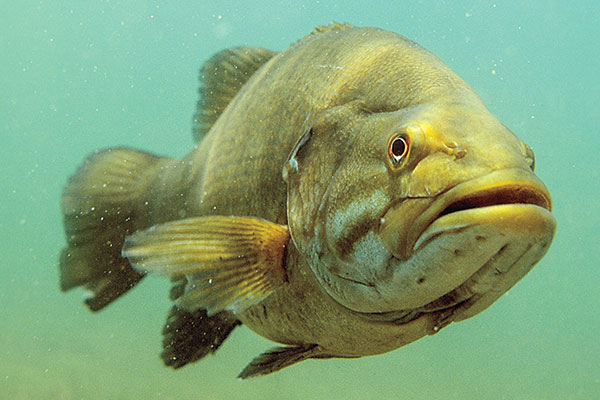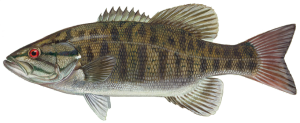By Pat Kirmse
Spring
A warm March rain raised the temperature of the Fox River to 47 degrees and a 15″ smallmouth bass starts to stir. She is five years old  and has survived another Illinois winter, the coldest and snowiest in her life. Fortunately there were no heavy midwinter rains that would have blown her out of her wintering area and forced her to use precious fat stores for energy. She outlived 90% of her class. Most died young from too little fat stores for winter hibernation. Eggs are developing in her ovaries and she needs food. She moves upstream to a school of spotfin shiners and eats 5 before the school scatters. That will hold her for 2 days.
and has survived another Illinois winter, the coldest and snowiest in her life. Fortunately there were no heavy midwinter rains that would have blown her out of her wintering area and forced her to use precious fat stores for energy. She outlived 90% of her class. Most died young from too little fat stores for winter hibernation. Eggs are developing in her ovaries and she needs food. She moves upstream to a school of spotfin shiners and eats 5 before the school scatters. That will hold her for 2 days.
The first heavy rain of April overloaded the local town’s antiquated sewer system, forcing the discharge of untreated sewage for 8 hours. Many small fish were killed by the high ammonia levels, larger fish were strong enough to move upstream of the toxic flow.
It was now mid May and the bass moves to her spawning bay. She was hatched here, as were 80% of the smallmouth bass in this pool of the river. Some bass look for new spawning areas, but the dams on the Fox River prevent any upstream movement. This would provide an advantageous mixing of the gene pool.
A 13″ male has brushed clean a bed in the gravel next to a football-sized rock. She moves in and lays thousands of eggs. She then leaves to feed and recover the weight she has lost. The male keeps the eggs free of dirt and silt. It is a difficult task due to the fact that introduced common carp are also spawning. The carp try to eat the eggs and the spawning activities in the shallows near the bed cloud the water with dirt and silt. Only half the eggs hatch. On a nearby nest, a poacher catches and keeps the guarding male. All of her eggs are eaten by carp.
Summer
 The water is very warm this July. The temperature of the water is 86 degrees and the bass must eat twice a day just to maintain her weight. The phosphates from sewage treatment plants fuel the tremendous growth of the algae. At night, the algae absorb oxygen and levels in the river drop to 1 parts per million (ppm), too low for the bass to live, so she moves into the small riffles.
The water is very warm this July. The temperature of the water is 86 degrees and the bass must eat twice a day just to maintain her weight. The phosphates from sewage treatment plants fuel the tremendous growth of the algae. At night, the algae absorb oxygen and levels in the river drop to 1 parts per million (ppm), too low for the bass to live, so she moves into the small riffles.
Standing in the riffles are several great blue heron waiting for fish. Minnows are also in the riffles and the herons eat both bass and prey. Our bass has 2 scars on her back from a run in with a heron when she was two years old.
Fall
October is do or die time for the aging bass. She has grown another inch since spring and gained 1/3 of a pound. If she doesn’t feed effectively over the next 4 weeks, she will not have enough fat to survive on for the winter. In cleaner waters at this latitude smallmouth bass can live twelve years. Here, few bass live to six years old, and none in the Fox River live past eight.
This year there was a good hatch of bluegills, emerald shiners, and spotfin shiners. It looks like she might make it to spring.




Best smallie article I’ve read anywhere in a long time. Hits close to home and really makes you stop and think. Great writing!